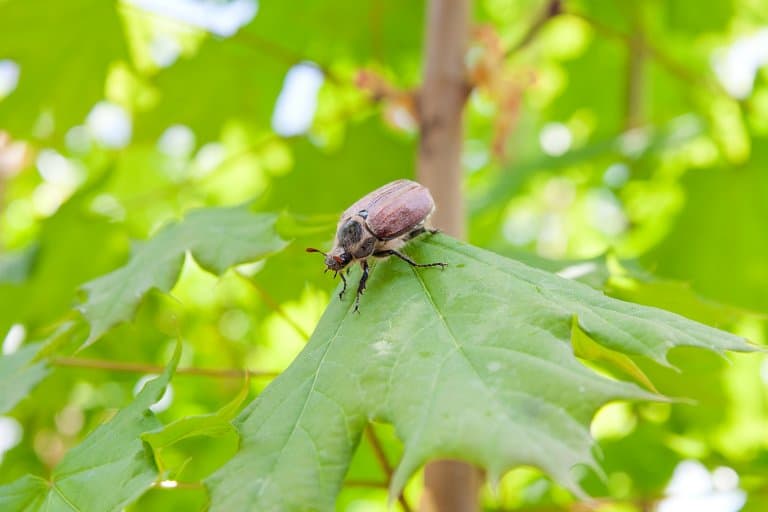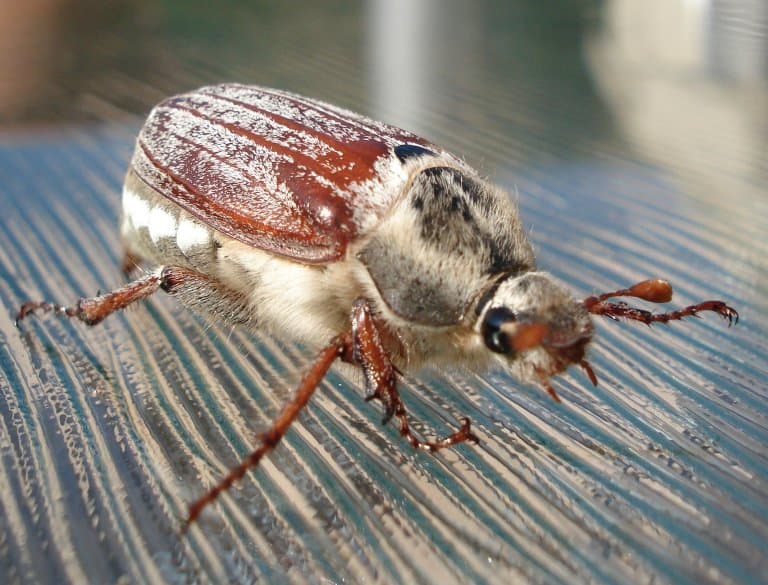Cockchafer Profile
Centuries ago, fashionistas were looking into how to make a pair of quality thermal underpants that didn’t require vast amounts of cotton field monoculture, plastic, or the boiling alive of silkworm larvae.
A fluffy little scarab beetle was put forward as a candidate, its fine, chitinous fur was thought to be the inspiration for the Ancient Egyptian’s obsession with them.
Countless billions of beetles were shaved to make the prototype. Needless to say, it was not a success, and the beetle was left with a very mean nickname.
Okay, none of this is true, but keep reading for lots of real facts about the cockchafer beetle.

Cockchafer Facts Overview
| Habitat: | Deciduous woodland |
| Location: | Europe |
| Lifespan: | About 4 years |
| Size: | Up to around 3cm (12 inches) |
| Weight: | <1g |
| Color: | Brown |
| Diet: | Grass and clover roots, fruit trees as adults |
| Predators: | Birds, bats, rodents, hedgehogs, French people |
| Top Speed: | Slow |
| No. of Species: |
3 |
| Conservation Status: |
Not Listed |
The cockchafer, is also known as the Maybug, Maybeetle, or doodlebug – but all these names are often given to any beetle from Europe without real thought.
Cockchafers, aside from having a hilarious name, have been serious pests throughout the ages.
They feed on the roots of fruit trees and come out in their millions, almost from nowhere to create so much stress that they’ve been taken to court over it.
These beetles are bulbous and clumsy relatives of the heavily-admired Egyptian dung beetle, but far from representing life and rebirth, they’ve been associated with much worse.
Modern pesticides have decimated their populations in many places, but recent reductions show promising potential for their return to deciduous woodlands throughout the continent.
Interesting Cockchafer Facts
1. It’s not what it sounds like
While the name for this beetle seems like it has come out of a Monty Python sketch, it’s derived from the Old English for “large chewer”.
Back then, we were all speaking a sort of German, and a lot of the words have been carried over. Cock refers to a grand old unit of whatever kind, and Chafer is derived from the Germanic word for something that chews.
This name is likely based on how much of a pest the larvae can be. While their numbers have been decimated alongside the rise of pesticides Europe-wide, before that they have been known to gnaw on the roots of crops to the extent that they were responsible for a full-blown plague in Ireland in 1688.

2. They do have fur
This beetle looks like a boiled sweet that’s been dropped onto a carpet. It’s coated in a cosy-looking fluff that resembles a woollen sweater, likely to help keep it clean, or possibly as a dampener against bat calls.
Insect fur is made of thin filaments of chitin, the same thing that makes up their exoskeleton. It’s a polysaccharide, very similar to cellulose, the plant’s structural carbohydrate.
So, it’s not like mammal fur at all, which is why they don’t make good thermal undies. 1
3. They’ve been historically tormented
There used to be a lot of these beetles around. In 1911, early pesticide methods involved collecting the adult beetles to try and reduce their population. One record states that 20 million of them were collected from an area of about 18 km2.
When they weren’t being wiped out as pests, they were used as toys; children would attach thread to their legs and fly them around like tiny sky puppies.
There are also French recipes for cockchafer soup, which requires 500g of them. Nowadays, though, you’d be hard-pressed to find that many.
As modern pesticides became the agents of mass destruction they are today, cockchafer populations tanked and they became extinct in many areas of Europe. 2 3

4. Irrational and imperfect creatures
At least, according to documents from 1478, during which time a trial was arranged against the beetles, accused of destroying crops at the behest of witches and banished from the area.
A year later, the troublesome arthropods were back in court, accused this time of “creeping secretly in the earth”, a crime which got them banished again. 4
5. They sing
It seems as though a lot is going on under the ground that we weren’t privy to. We know that gnawing grubs and beetles make a crunching sound in the Earth and that their movements also create noise as they go, but it’s coming to light that there’s a whole cacophony of deliberate communication down there, too.
Scarab beetle larvae seem to grind their teeth to talk to one another – a behaviour known as stridulation. These calls are distinctive enough that a particularly-committed beetle nerd can tell the species apart just by listening. 5
6. They can see well
Eyes are multifaceted, with 5,475 facets per eye, providing very acute vision.
They’re also sensitive to polarized light, suggesting that they use the polarization patterns in the sky to align themselves onto migratory paths.
They also have incredible, fanned antennae, which they can expand into feathery sensors to pick up the slightest of scents.
These antennae are one of the most reliable ways to tell males from females: females have six branches on theirs; males have seven. 6 7

7. They have 40-year cycles
Like Cicadas, chafers have a mysterious calendar. The larvae will grow rapidly for the first few months, then slow down over Winter.
As the temperature rises again, the larva will suddenly resume eating and growing, ending in Winter, at which point it will hibernate.
By the time year 3 comes along, it’s ready to finish growing and will mature by the late Summer. Still, the adult will remain inactive throughout Winter, emerging the following Spring.
This gives the beetle a 4-year cycle of activity, when there’s a burst of cockchafer activity. But an even more peculiar and powerful “outbreak” cycle seems to follow a 30 or 40-year pattern.
At the end of this cycle, vast numbers of cockchafers emerge all at once and have caused significant damage over the centuries and can even threaten the sustainability of Europe’s forests, still. 8, 9
Cockchafer Fact-File Summary
Scientific Classification
| Kingdom: | Animalia |
| Phylum: | Arthropoda |
| Class: | Insecta |
| Order: | Coleoptera |
| Family: | Scarabaeidae |
| Genus: | Melolontha |
| Species Names: | M. melolontha M. hippocastani M. pectoralis |
Fact Sources & References
- Lee A. Miller (2001), “How Some Insects Detect and Avoid Being Eaten by Bats: Tactics and Countertactics of Prey and Predator: Evolutionarily speaking, insects have responded to selective pressure from bats with new evasive mechanisms, and these very responses in turn put pressure on bats to “improve” their tactics”, Oxford Academic.
- (2006), “Bug has a long, colourful history”, Irish Examiner.
- Jen Stout (2016), “Seeking Romance: the Cockchafer”, Bugsfeed.
- Helen Sullivan (2021), “A Christmas beetle: in England they’re called ‘cockchafers’”, The Guardian.
- Carolyn Goerres (2019), “COCKCHAFER- Singing in the soil”, Carolyngorres.com.
- “Fan-like Antennae Aid Sensing-Grapevine beetle”, Asknature.
- T. Labhart (1992), “Specialized ommatidia for polarization vision in the compound eye of cockchafers, Melolontha melolontha (Coleoptera, Scarabaeidae)”, NIH.
- Marzena Niemczyk (2023), “Outbreaks of cockchafers – how do genetic population structures of Melolontha melolontha and M. hippocastani differ?”, Research Square.
- Jared Cardiff “Melolontha melolontha-common European cockchafer”, Animal Diversity Web.
